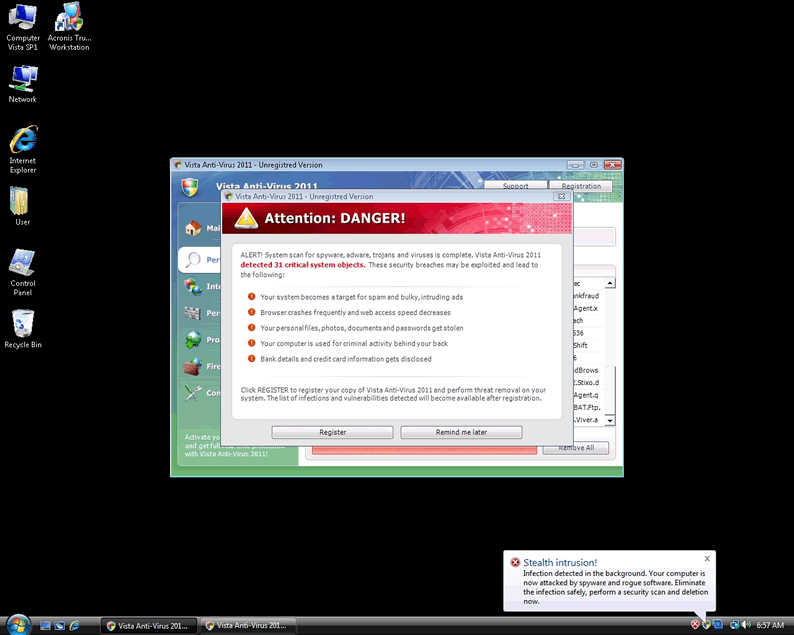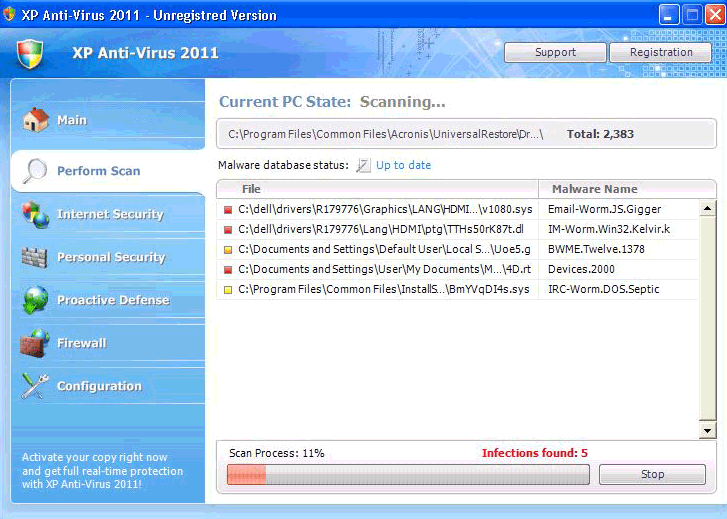Anti-Virus 2011
Anti-Virus 2011 is such a ubiquitous phrase that Anti-Virus 2011 hardly seems like the name of anything dangerous. After all, many legitimate anti-virus programs will include "Anti-Virus 2011" in their product names. However, if you have a program that is called just Anti-Virus 2011 on your computer, and Anti-Virus 2011 is hounding you for money, then your computer is infected with malware. Anti-Virus 2011 is fake security software that preys on Windows users.
Table of Contents
What Anti-Virus 2011 Really is, and the Symptoms that Anti-Virus 2011 Causes
Anti-Virus 2011 comes from a large malware "family" that really only contains one piece of malware. It looks as though there is a whole, huge family of related fake anti-virus applications that all cause the same symptoms – but the truth is, there is just one piece of malware, and Anti-Virus 2011 renames itself according to what Anti-Virus 2011 finds on your computer. In particular, Anti-Virus 2011 looks to see which version of Windows you're using, and Anti-Virus 2011 uses that as part of its name. Then, Anti-Virus 2011 chooses one or two generic, security-related words or phrases, or one word and one year, and Anti-Virus 2011 combines that with the name of your Windows product. So when the malware announces Anti-Virus 2011's presence, there Anti-Virus 2011 is, with a plausible-sounding name that is just one of very many possible combinations of keywords.
Occasionally, this malware will infect a computer and for whatever reason, Anti-Virus 2011 will be unable to figure out which Windows product you're using. When that happens, you can get a result like Anti-Virus 2011. So that's what it calls itself, and Anti-Virus 2011 proceeds from there just like any other rogue anti-virus program, by using scare tactics to try to manipulate you into paying money for malware.
The first time you see Anti-Virus 2011 will be when you start Windows, and Anti-Virus 2011's fake user interface appears. This interface is configured to show up the first time any program runs after the computer starts, but because practically everyone has something that runs at start-up – a printer status monitor, an anti-virus application, a chat program, etc. – the effect is that Anti-Virus 2011 will run when the system starts. This interface uses the Windows logo, and Anti-Virus 2011 may use the Windows name. Anti-Virus 2011 has several icons that are supposed to represent your computer's security, which Anti-Virus 2011 will always give a very low rating. Generally, the interface is supposed to look realistic, so that you will believe that the fake scans that Anti-Virus 2011 shows are real.
When Anti-Virus 2011 runs one of its "scans", there really isn't anything you can do to prevent it, but then again, all Anti-Virus 2011 is really doing is showing a progress animation. Anti-Virus 2011 can't actually scan for anything. So, when Anti-Virus 2011 gives you a list of results, that list is obviously fake. Nonetheless, the list can include the names of real viruses in the results, just to scare you. If you try to find the threats that Anti-Virus 2011 says it found, you will find that not only are the threats not present on your computer, but the files that Anti-Virus 2011 marked as malicious are just harmless, ordinary Windows components. The list was created to persuade you that you have viruses on your PC that only Anti-Virus 2011 can remove, because after you tell Anti-Virus 2011 to remove all of the threats, Anti-Virus 2011 will tell you that you need to activate Anti-Virus 2011's software in order for that to be possible. Activation isn't free, and Anti-Virus 2011 will direct you to a payment site, which really will take your money if you enter your credit card information. Don't do that! Anti-Virus 2011 will not change into real software just because you paid for Anti-Virus 2011.
Once you get past the phony interface, Anti-Virus 2011 will continue to try to get you to pay an activation fee. Anti-Virus 2011 will cause security alerts to pop up, many of which may say that they are Firewall alerts. These alerts will mention urgent security issues that Anti-Virus 2011 says it has detected, and one way or another, they all contain prompts that are meant to lead you to the payment site. Anti-Virus 2011 will also interfere with your web browser, by either redirecting it when you try to visit ordinary sites, or by preventing you from going to a site with a fake in-browser security alert warning you that you have just been prevented from navigating to a malicious site. Don't expect to be able to remove Anti-Virus 2011 through ordinary means, either, because Anti-Virus 2011 will prevent you from using any other programs, and Anti-Virus 2011 probably will not be listed in the Add/Remove Programs option in the Control Panel, either. Anti-Virus 2011 cripples Windows when Windows is running in its normal mode.
How Did Anti-Virus 2011 Get Onto Your PC in the First Place?
Anti-Virus 2011 is really a secondary infection. Anti-Virus 2011 is able to get into your PC because of a Trojan called Trojan.Win32/FakeRean. This Trojan is commonly hidden in fake video codec updates on adult websites or bundled with downloads from file sharing services. Once you have unknowingly downloaded Anti-Virus 2011, the Trojan downloads Anti-Virus 2011, and Anti-Virus 2011 may even disguise the download as a Windows update. The next time you start Windows, Anti-Virus 2011 will be active.
Related Malware and Anti-Virus 2011 History
This malware scam is known to be based in Russia, and Anti-Virus 2011's malware family has been around since 2008. In fact, Anti-Virus 2011 first showed up as a name for the malware in April 2010, and then Anti-Virus 2011 died out for a while, possibly because it was so early for any software to be calling itself a 2011 version that PC users found it suspicious. However, this name-changing malware has been causing a lot of infections in 2011, and "Anti-Virus 2011" is one of its variants – which is now current and plausible-sounding enough as a name to be able to scam people.
File System Details
| # | File Name |
Detections
Detections: The number of confirmed and suspected cases of a particular threat detected on
infected computers as reported by SpyHunter.
|
|---|---|---|
| 1. | av2011.exe |



